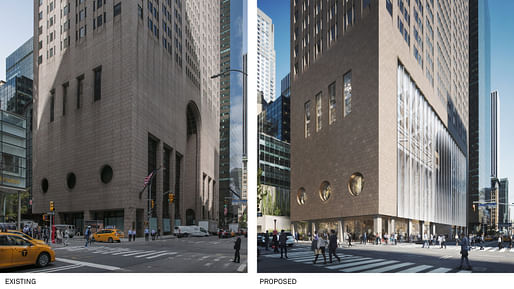
A week to the day in which Norwegian design firm Snøhetta released their ambitious designs to modernize Phillip Johnson's Postmodern icon — the AT&T building in New York — Norman Foster has come out and added his name and gravity in support of the building protests against the proposed modifications.
In a short, precise and two-edged statement posted on Instagram no less, Norman Foster defends the project, not for its importance to him, or his interests per se but to Architecture's heritage at large — one that would be potentially soiled with Snøhetta's revamp.
‘I was never sympathetic to the short-lived Postmodern movement – and this building in particular. However, it is an important part of our heritage and should be respected as such.'
While no one would declare the building a masterpiece through and through, it has always stood as more than a building, it has come to signify so much more. Johnson's design radically shifted our view of Architecture; it turned history into a malleable object, ripe for intervention and playfulness. The building was never just a building; it was never solely an extruded cabinet of endless meanings — it was a statement, a declaration of style and change.

The design has a long history of both admiration and prejudice, which in itself has turned it into a staple of Architectural discourse. The 647-foot icon was completed by Philip Johnson partner John Burgee in 1984 as the headquarters for the telecommunications company. It is considered the world's first skyscraper built in the postmodern style and continues to this day to be a poster child of the movement.
That may be where Snøhetta's proposed revamp has failed, in that through it, they are potentially eradicating the building's voice and stance — ripping the floor from under its feet and covering it in glazing.
* To further explore Philip Johnson's views on architecture, enjoy this interview form 1992 below where he discusses his concepts, theories, and growth as an architect.
5 Comments
i don’t care for the heritage argument. With any architecture project, It comes down to whether there’s is improvement or not. This is clearly not.
many, like Foster, use this as a flashpoint to make larger points about what they like (postmodernism, public space) but it’s usually beside the point
Architectural history is lame. One only needs to look at the motivations behind New York's art deco sky scrapers to see that. The idea, then, is to preserve these lame stories as a permanent record of our species' idiocy. The story of this building is no exception. Charles Jencks pasted it as an addendum in a book he was rushing to press, to define a style according to a theory he had concocted, to secure work as a writer and speaker about architecture, rather than having to practice himself. Soon everyone was talking about the building that looked like a wardrobe—so shocking! Now what fool would want to erase such a story as that?
I worked with Norman Foster many years ago in the same office in San Francisco. I had a high regard for him then just out of architectural school and now. I tend to agree with him on the modification of Philip Johnson's AT&T building. I also did not like Johnson's style, but it was a major influence in its day and changing it years later tends to give architects the shivers; simply because times change and what was relevant then may not be relevant now. But realistically commercial architecture is always going to be subject to change, because of the nature of it use, as opposed to a civic building or a cathedral. I somehow don't think Norman has to worry about his buildings being changed in later years.
...even thinking of modifying buildings that are a part of a country's heritage is just ridiculous!!!!
Anyway, I'm not a big fan of P. Johnson but his interviews, like the 1992 one, are always interesting to listen to.
Block this user
Are you sure you want to block this user and hide all related comments throughout the site?
Archinect
This is your first comment on Archinect. Your comment will be visible once approved.